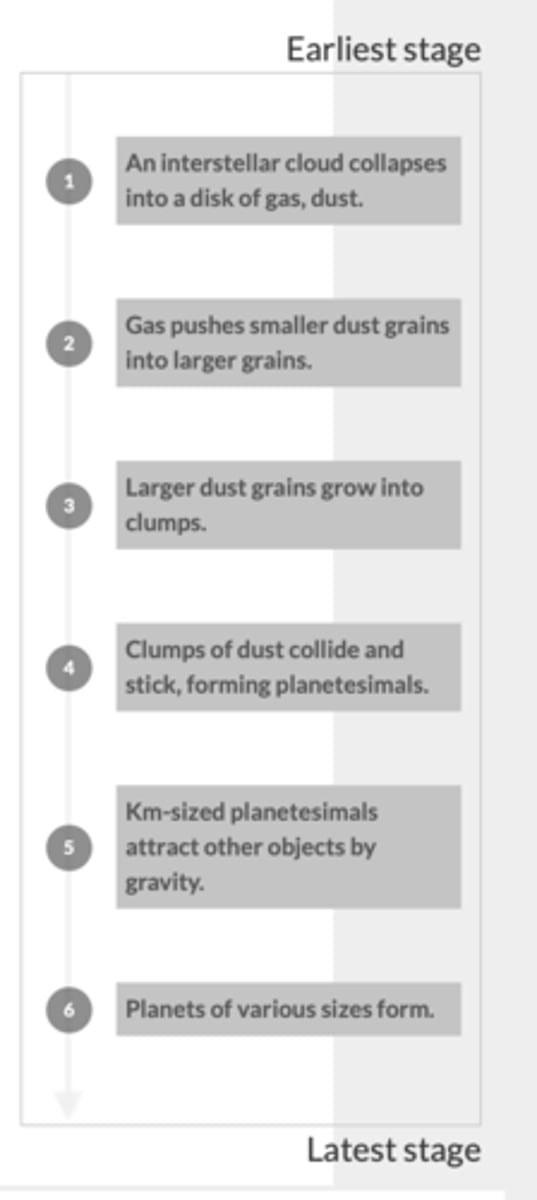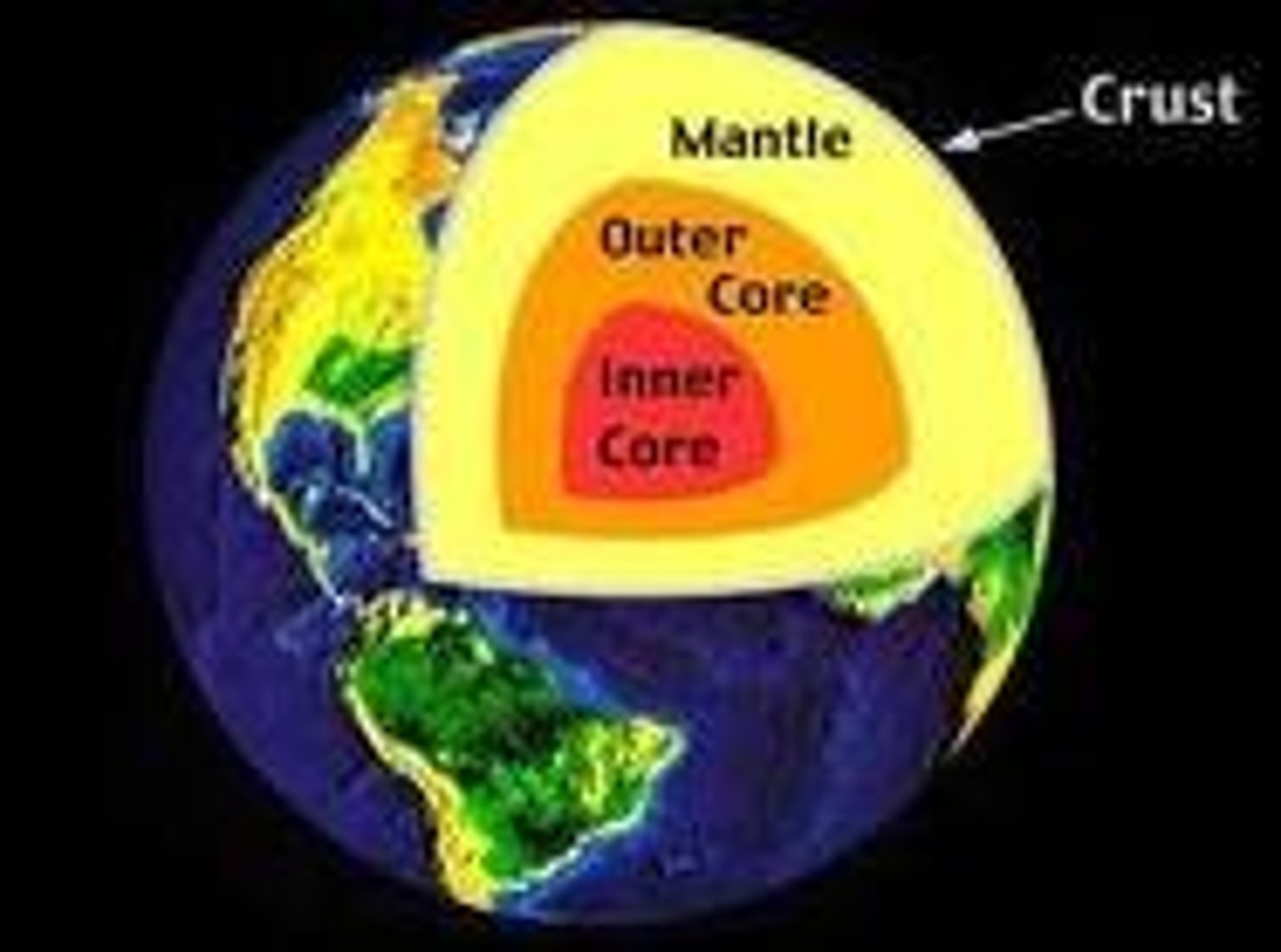Phisics and the universe
1/73
There's no tags or description
Looks like no tags are added yet.
Name | Mastery | Learn | Test | Matching | Spaced |
|---|
No study sessions yet.
74 Terms
When dust grains first begin to grow into larger objects, this occurs because of:
collisions between dust grains.
Planetary systems are probably
exceedingly common-every star has planets.
The direction of revolution in the plane of the Solar System was determined by
the direction of rotation of the original cloud.
The radial velocity method preferentially detects:
large planets close to the central star.
Nuclear reactions require very high _____________ and _____________.
temperature; density
The transit method preferentially detects
large planets close to the central star.
A planet in the "habitable zone"
is at a distance where liquid water can exist on the surface.
Since angular momentum is conserved, a spinning ice-skater who extends her arms out will
rotate more slowly.
The terrestrial planets and the giant planets have different compositions because
the terrestrial planets are closer to the Sun.
A molecular cloud fragments as it collapses because
density variations from place to place grow larger as the cloud collapses.

Molecular clouds range in mass from a few times the mass of our Sun (solar masses) to 10 million solar masses. Individual stars range from 0.08 to about 150 solar masses. What does all of this imply about how stars form from molecular clouds?
A single molecular cloud fragments as it collapses, forming many stars at once.
The Sun also likely formed in a cluster, from a single molecular cloud that fragmented to form hundreds or thousands of stars at once with a full range of masses. Yet the Sun (and most other stars) is currently a single star, with no sign of the siblings it formed with.
They moved away from the Sun over the past 4.5 billion years.
Study the sizes of the gas giants shown in the image above (the distance from the Sun increases from left to right), and choose the best explanation that accounts for their differences in size.
Gas giants decrease in size with increased distance from the Sun because the Solar Nebula was less dense farther out.
What happens to the appearance of an object as it gets hotter?
A. The object gets bluer.B. The object gets brighter.
Scientists learn about the interior structure of terrestrial planets by using
observations of magnetic fields.
models of Earth's interior.
observations of seismic waves.
On which of the following do plate tectonics still occur?
Mars
Mercury
Earth
Lava flows on the Moon and Mercury created large, smooth plains. We don't see similar features on Earth because Earth
has plate tectonics that recycle the surface.
Erosion is most efficient on planets with:
wind and water.
On which of the following is wind erosion negligible? Select all that apply.
Moon
Mercury
Erosion by wind and water has occurred on which of the following? Choose all that apply.
Mars
Earth
Geologists can determine the relative age of features on a planet because
the ones on top must be younger.
Geologists can find the actual age of features on a world by
comparing cratering counts on one world to those on another.
radioactive dating of rocks retrieved from the world.
Impacts on the terrestrial worlds
are less common than they used to be.
Scientists know the history of Earth's magnetic field because
the magnetic field freezes into rocks, and plate tectonics spreads the rocks out.
Why are there two high tides? That is, what causes the tide on the side of the Earth away from the Moon?
The difference in force between the two sides of the planet causes both to bulge out.
Which astronomical body dominates the tides on Earth?
the Moon
It is unlikely that the Moon formed elsewhere and was captured by Earth's gravity, since it may be impossible for the Earth to capture an object as large as the Moon. It is also of note that the Moon contains an unusually low quantity of volatiles, which are materials like water that are easily vaporized at high enough temperatures.Based on this, and given the Moon's density, which of the following formation scenarios of the Moon most closely matches our observations?
The Moon accreted from the debris of the impact of a large object with the surface of the Earth.
Why do the Hawaiian Islands form a chain?
As the tectonic plate moves over a hot spot, volcanoes form at successive locations.
The ____________ of greenhouse gas molecules affects the temperature of an atmosphere.
number
Venus is hot and Mars is cold primarily because
Venus has a much thicker atmosphere.
Auroras are the result of
the interaction of particles from the Sun and Earth's atmosphere and magnetic field.
The ozone layer protects life on Earth from
ultraviolet radiation.
Hadley circulation is broken into zonal winds by
the planet's rapid rotation.

The oxygen molecules in Earth's atmosphere
are the result of life.
Studying climate on other planets is important to understanding climate on Earth because
A. other planets offer a range of extremes to which Earth can be compared.B. other planets can be used to test atmospheric models.C. comparing climates on other planets helps scientists understand which factors are important.D. underlying physical processes are the same on every planet.
The Coriolis effect causes winds to
circulate east and west.
Which of the following statements are true? Select all that apply.
A. Earth's magnetosphere extends far beyond Earth's atmosphere.B. Earth's magnetosphere is essential to the formation of auroras.C. Earth's magnetosphere shields us from the solar wind.D. Earth's magnetosphere is weaker than Mercury's.
Select all that apply. The atmospheric greenhouse effect is present on
A. Venus.B. Earth.C. Mars.
The words weather and climate
A. refer to very different size scales.B. refer to very different time scales.
elements primary atmosphere
helium and hydrogen

elements secondary atmosphere
carbon dioxide, water, oxygen, nitrogen
planet secondary atmosphere
mars
earth
venus
planet no atmosphere
moon
mercury
least to most thick atmosphere
mars, earth, Venus
Choose the statement that corresponds to the biggest factor that resulted in Mars having a thinner atmosphere than Earth and Venus.
Mars is less massive than Earth and Venus.
Lighter molecules (like hydrogen and helium) tend to escape from an atmosphere more often than heavier ones (like carbon dioxide and nitrogen) because they
are moving faster.
The main greenhouse gases in the atmospheres of the terrestrial planets are
carbon dioxide and water vapor
All weather and wind on Earth are a result of convection in the
troposphere
As Earth's temperature rises, how are Earth's oceans affected?
A. Ocean currents change. B. Sea level rises as meltwater is added. C. Sea level rises because of expansion. D. CO2 is released from the deep ocean.
The differences in composition among the giant planets support the model of the formation of stars and planets because the model predicts that:
more massive planets will hold onto more hydrogen and helium.
Deep in the interiors of the giant planets, water is still a liquid even though the temperatures are tens of thousands of degrees above the boiling point of water. This can happen because
the pressure inside the giant planet is so high.
Measurements of the magnetic fields of the giant planets indicate what about the interior?
The interiors contain flowing, electrically conductive materials.
Saturn's bright rings are located within the Roche limit of Saturn. This supports the theory that these rings
are formed of moons torn apart by tidal stresses.
If rings are observed around a planet, this indicates that
there is a recent source of ring material.
Zonal winds on the giant planets are stronger than those on the terrestrial planets because
the giant planets rotate faster.
Stellar occultations are the most accurate way to measure the _________ of a Solar System object.
diameter
The chemical compositions of Jupiter and Saturn are most similar to those of
the Sun.
Uranus and Neptune are different from Jupiter and Saturn in that Uranus and Neptune
have a higher percentage of ices in their interiors.
The Great Red Spot on Jupiter is
a storm that has been raging for more than 300 years.
Metallic hydrogen is not:
a metal that acts like hydrogen.
Metallic hydrogen is
a metal that acts like hydrogen.
Which of the giant planets has the most extreme seasons?
Uranus
An occultation occurs when
a planet passes between Earth and a star.
Why is Jupiter reddish in color?
because of the composition of its atmosphere
When viewed through a telescope, Uranus and Neptune are distinctly bluish green in color. What gas is responsible for this striking appearance?
methane
What causes the auroras of the giant planets?
charged particles
strong magnetic fields
If Saturn's rings are made of individual small particles at varying distances from the planet, and given what you know of the laws of physics as governed by gravity, how would you expect these particles to behave?
The particles closer to Saturn will orbit faster around the planet than those farther away.
Consider the case of a single particle within the rings that has a highly elliptical and/or highly inclined orbit, such that its orbital shape is different from the other particles in the ring. What will likely happen to that particle?
Collisions with other particles and the gravitational force of the rings will gradually nudge it into a more circular orbit within the flat plane of the rings.
Which of the following mechanisms contribute significantly to the formation of planetary rings?
destruction of a moon by tidal forces
If you wanted to search for faint rings around a giant planet by sending a spacecraft on a flyby, it would be best to make your observations
after the spacecraft passed the planet.
Jupiter and Saturn, despite being considerably farther from us than the inner terrestrial planets, are very bright in our sky. Which of the following choices are possible explanations for this?
They are larger than the terrestrial planets.
They are more reflective (higher albedo) than most of the terrestrial planets.
After Uranus was discovered, astronomers predicted it's orbit using Newton's laws of motion and gravity. To their surprise, they observed that Uranus's motion through the sky did not match their predictions. Newton's laws had worked extremely well for all the other planets, so which of the following was the most logical next step for the astronomers to take?
Check for any other factors that might alter Uranus's orbit but still allow it to obey Newton's laws of motion and gravity.
Uranus's orbit did not appear to behave according to Newton's laws of motion and gravity. The most likely culprit for Uranus's misbehaving orbit was the gravitational influence of another planet. Using Newton's laws, astronomers were able to calculate exactly where they would expect this still-undiscovered planet to be. When telescopes were pointed at this position, Neptune was seen. What does this imply?
Newton's laws have been verified by yet another test, so we should use them with high confidence until and unless they are falsified by future tests.